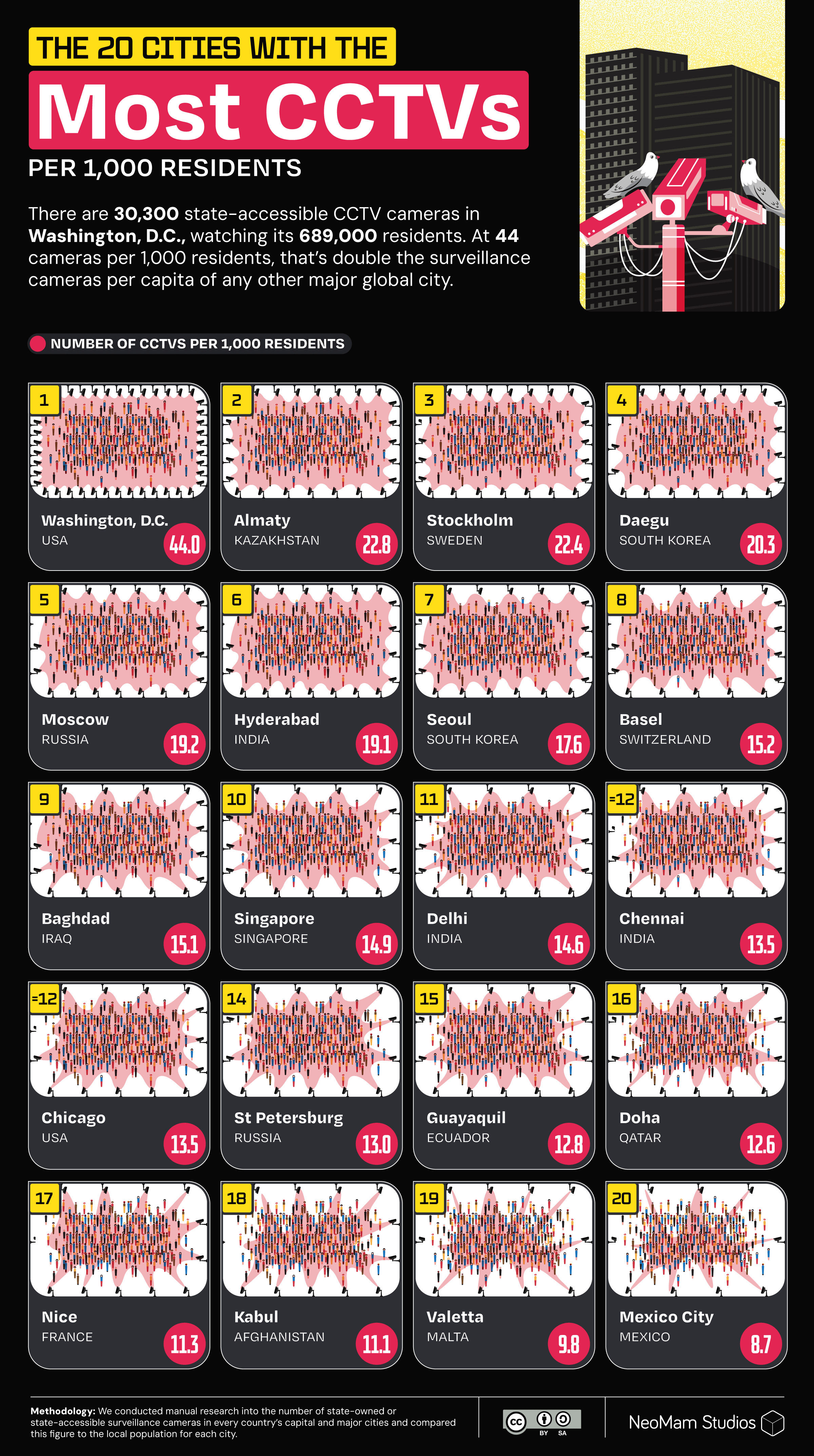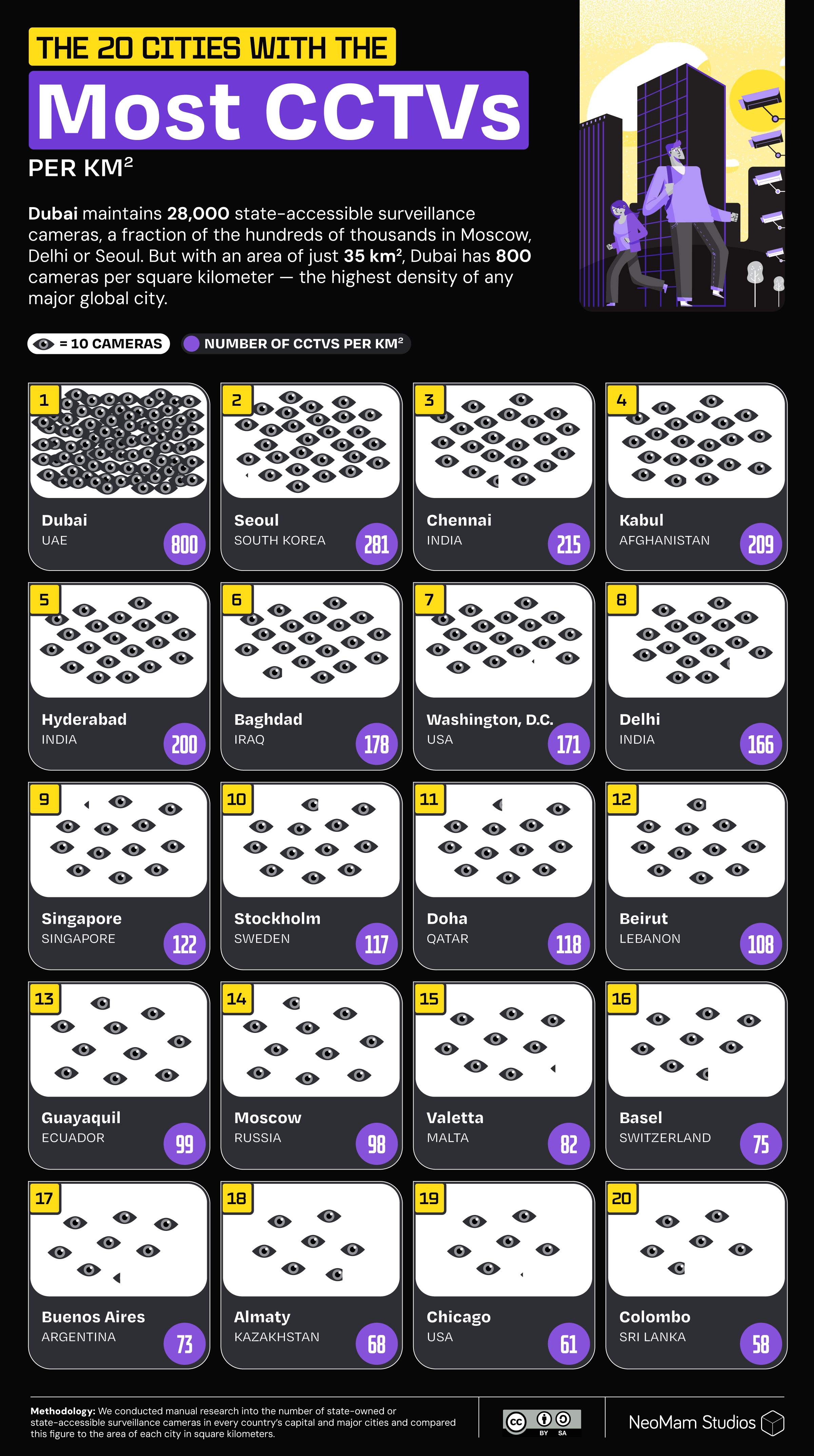State surveillance technology just got supercharged.
Over the past few years, in addition to boosting their own fleet of surveillance cameras, global governments have invested in so-called “plug-in surveillance networks,” encouraging citizens with business or home CCTV systems to share their surveillance feed with the authorities.
Meanwhile, massive advances in AI technology have enabled the teams monitoring these feeds to analyze and track everything from license plates and objects to faces and the way that you walk.
Some of the countries most associated with repressive regimes have demonstrated just how this technology can be misused. In China, there’s a thriving black market for state surveillance data. In Moscow, Russia, authorities used this technology to round up conscripts to send to war. But neither of these is home to the densest configuration of surveillance cameras.
For this report, we identified the cities worldwide with the largest number of government-linked CCTV cameras per 1,000 people and km2.
To find out, we conducted manual research to find local reports of CCTV camera counts in the capitals and major cities of every country. We included CCTV cameras controlled or accessible by the government but excluded private, unnetworked CCTV cameras from the totals. Finally, we used the latest population counts and land area for each city to calculate the density of cameras per 1,000 residents and square kilometres.
| → In Washington, D.C., there are 44 government-accessible surveillance cameras per 1,000 people — the highest of any major global city. → The city with the most state-accessible CCTV cameras per km2 is Dubai (United Arab Emirates), where there are 800 cameras per km2. → Stockholm (Sweden) is the most surveilled European city with 22.4 CCTV cameras per 1,000 residents, or 117 cameras per km2. → Two South Korean cities appear in the top 20 rankings: Daegu with 20.3 CCTV cameras and Seoul with 17.6 state-accessible cameras per 1,000 residents. → In South America, Guayaquil (Ecuador) and Buenos Aires (Argentina) ranked among the top 20 cities with the highest density of government-monitored CCTV cameras, with 99 and 73 cameras per km², respectively. |
Washington, D.C., has more cameras per head than any major city
And the Mayor’s office has budgeted to triple the camera count imminently.
First, we visualized the number of CCTV cameras available to the government network in every major city compared to the local population size. While Moscow makes the top five with 19.2 cameras per 1,000 people, the city with the highest CCTV density of all has almost twice the number of cameras per head of any global city: Washington D.C., where there are 44.0 cameras per 1,000 people.
Despite maintaining the most thorough CCTV network of any city, D.C. authorities are investing millions more in “crime-fighting technology,” including $13 million to triple the local camera fleet and $322,000 to boost payouts to businesses for sharing their private security feeds.

“Video continues to play a key role in not just allowing us to identify a suspect, but also ensuring the criminal justice ecosystem holds that suspect accountable,” says Metropolitan Police Department (MPD) Chief Pamela A. Smith.
However, the system is vulnerable to abuse and misuse by institutions and criminals alike. The American Civil Liberties Union (ACLU) says that already-overpoliced communities face the greatest threat to their civil rights, which remain in flux; Vice reports that stalkers and bounty hunters have tricked telecom companies into releasing personal data. And in Washington, D.C., itself, back in 2017, cyber criminals infected two out of three surveillance network video recorders, intending to demand a ransom to unlock the affected systems.
Dubai has nearly three times as many cameras per km2 as any other city
Washington, D.C., has more per square kilometer than Singapore, Doha or Moscow.
There are presently 171 government cameras per square kilometer in D.C. — the seventh highest density by area of any major global city. Seoul and Stockholm, which accompany D.C. among the top five per 1,000 people, are also among the top ten per square kilometer.
But the city with the most CCTV cameras by area has a camera density nearly three times higher than any other. Dubai, the largest city in the United Arab Emirates, has 800 cameras per km2, followed by Seoul with 281.

Emirati authorities have “a zero-tolerance policy toward criticism of the government,” according to Human Rights Watch, “and enforce that policy with an arsenal of invasive surveillance tools, including, in the worst cases, by directly monitoring messages, emails, and mobile devices.” Authorities have also used the Israeli spyware Pegasus to crack dissidents’ mobile devices.
“Nowadays, the police force, they don’t think about the guns or weapons that they’re carrying,” Maj. Gen. Khalid Alrazooqi, the Dubai Police’s general director of AI, told the New York Times in 2023. “You’re looking for the tools, the technology.”
CCTV cameras are the eyes of a complex surveillance network
Our data reveals number and density of CCTV cameras in every major global city.
Authorities and the tech companies that supply them continue to insist that tech advances will do more good than harm. Markus Lai is a training manager with the company that provides Stockholm’s Metro cameras. He says that with today’s AI and camera technology, “it is now possible to deploy video solutions with advanced deep learning analytics that can reliably classify and analyze objects and people, thereby seeing patterns in behavior and movement for statistical analysis,” and that this analysis can help solve crime and prevent accidents.
Stockholm has around 22,000 government-networked cameras, creating the third-highest density per person and the tenth-highest by area. You can check the stats on Stockholm and 178 other major global cities in our interactive table, below.
Meanwhile, in the U.S., communication tech companies now maintain close links with government agencies. The implications for freedom of speech and movement as Washington redraws the lines of what it means to be part of American society are concerning.
“We’ve never seen in the history of the United States a stronger surveillance capacity paired with weaker rule-of-law protections,” Albert Fox Cahn, executive director of the Surveillance Technology Oversight Project, told Axios during an uptick in requests for privacy advice following last year’s election. “It is a really dangerous combination.”
| Methodology: To discover the most surveilled cities in the world, we first built a seed list that included the capitals and most populated cities in every officially designated country. For countries with further globally recognised major cities, we included up to three additional cities. We then conducted manual research in the native language of each country to find local reports of CCTV camera counts in the city. We considered the following conditions: > We focused on the count of CCTV cameras controlled by the government or accessible by the government (private cameras linked to the government’s network). > We excluded private CCTV cameras from the totals. > For instances where the overall CCTV camera totals weren’t reported, we tallied the counts reported by the police, transport/metro and local government agencies. We then pulled the latest population counts and land area for each city as of March 2025 to allow us to calculate the density of cameras per 1,000 residents and per square kilometer. Note: Any missing cities reflect a lack of reputable sources with reliable data. This could reflect either a lack of transparency from the national or local government regarding surveillance, or simply that the city doesn’t have a significant CCTV presence to report on. |









